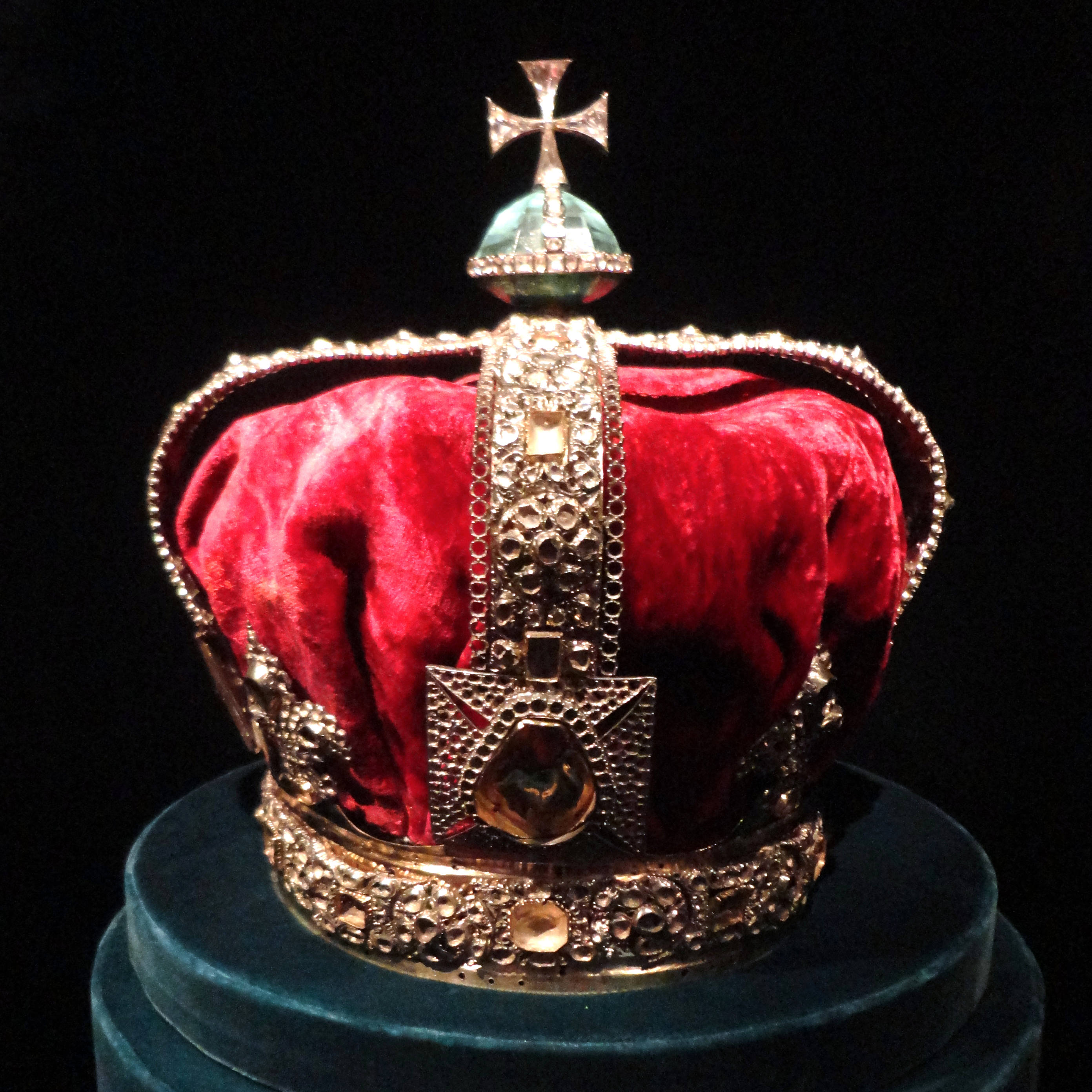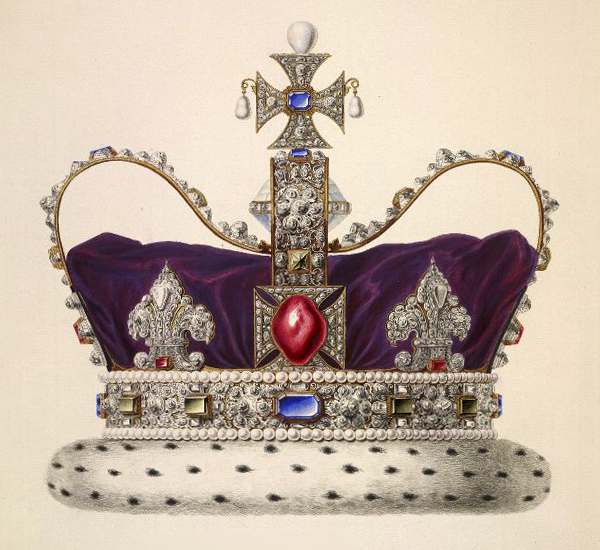State Crown of George I on:
[Wikipedia]
[Google]
[Amazon]
 The State Crown of George I is the imperial and state crown crafted in 1714 for King George I. It was modified and used by subsequent monarchs until 1838. The empty gold frame and its aquamarine
The State Crown of George I is the imperial and state crown crafted in 1714 for King George I. It was modified and used by subsequent monarchs until 1838. The empty gold frame and its aquamarine
 The crown is vibrantly depicted in a
The crown is vibrantly depicted in a
 The State Crown of George I is the imperial and state crown crafted in 1714 for King George I. It was modified and used by subsequent monarchs until 1838. The empty gold frame and its aquamarine
The State Crown of George I is the imperial and state crown crafted in 1714 for King George I. It was modified and used by subsequent monarchs until 1838. The empty gold frame and its aquamarine monde
A ''monde'', meaning 'world' in French, is an orb located near the top of a crown. It represents, as the name suggests, the world that the monarch rules. It is the point at which a crown's half arches meet. It is usually topped off either w ...
which dates from the reign of King James II
James VII and II (14 October 1633 16 September 1701) was King of England and King of Ireland as James II, and King of Scotland as James VII from the death of his elder brother, Charles II, on 6 February 1685. He was deposed in the Glorious Re ...
are both part of the Crown Jewels of the United Kingdom
The Crown Jewels of the United Kingdom, originally the Crown Jewels of England, are a collection of royal ceremonial objects kept in the Tower of London which include the coronation regalia and vestments worn by British monarchs.
Symbols of ov ...
. They are on public display in the Martin Tower at the Tower of London
The Tower of London, officially His Majesty's Royal Palace and Fortress of the Tower of London, is a historic castle on the north bank of the River Thames in central London. It lies within the London Borough of Tower Hamlets, which is sep ...
.
Origin
The crown, made by royal jeweller Samuel Smithin, replaced the state crown of Charles II (also used by his successors, James II, William III and Queen Anne) and incorporated some of the jewels and pearls from the old crown, with the addition of 265 new pearls, 160 diamonds, 6 emeralds and 2sapphire
Sapphire is a precious gemstone, a variety of the mineral corundum, consisting of aluminium oxide () with trace amounts of elements such as iron, titanium, chromium, vanadium, or magnesium. The name sapphire is derived via the Latin "sa ...
s, at a total cost of £1,440. Very little change was made to either the shape of the crown or the arrangement of the stones. The gold frame is tall, and the monde
A ''monde'', meaning 'world' in French, is an orb located near the top of a crown. It represents, as the name suggests, the world that the monarch rules. It is the point at which a crown's half arches meet. It is usually topped off either w ...
and cross surmounting it are tall.
Watercolour
 The crown is vibrantly depicted in a
The crown is vibrantly depicted in a watercolour painting
Watercolor (American English) or watercolour (British English; see spelling differences), also ''aquarelle'' (; from Italian diminutive of Latin ''aqua'' "water"), is a painting method”Watercolor may be as old as art itself, going back to ...
by Bernard Lens III, the miniature painter to the court of George II George II or 2 may refer to:
People
* George II of Antioch (seventh century AD)
* George II of Armenia (late ninth century)
* George II of Abkhazia (916–960)
* Patriarch George II of Alexandria (1021–1051)
* George II of Georgia (1072–1089) ...
, dated 1731. This date suggests that Lens had made a sketch of the crown before it was entirely reset in 1727 for George II but did not finish it until some time afterwards. The inscription reads:
The crown with which George I, King of Great Britain, was crowned on 20 October 1714. The cap is of crimson velvet or purple; welt of ermine; circle and arches of beaten gold. The ornaments are silver and set with diamonds; the larger stones are sapphires and emeralds, and a few small rubies. The balas in the cross in front was given to the crown by James II. The ball on which the upper cross is fixed is an aquamarine but the lower part is gold enamelled green. It is worn when the king goes to parliament, is made new for every coronation, and kept at the Tower of London.The "balas" mentioned here is the
Black Prince's Ruby
The Black Prince's Ruby is a large, irregular cabochon red spinel weighing set in the cross pattée above the Cullinan II diamond at the front of the Imperial State Crown of the United Kingdom. The spinel is one of the oldest parts of the Crow ...
, a large spinel that was actually in the state crown of Charles II, and is first mentioned in Tudor inventories as being set in a crown used by Henry VIII. The " aquamarine" dates from 1685, when it replaced the original monde
A ''monde'', meaning 'world' in French, is an orb located near the top of a crown. It represents, as the name suggests, the world that the monarch rules. It is the point at which a crown's half arches meet. It is usually topped off either w ...
in the state crown of Charles II, and was later found to be paste or coloured glass.
Subsequent use and fate
George I's state crown was subsequently used at the coronations of George II, for whom the arches were pulled upwards, andGeorge III
George III (George William Frederick; 4 June 173829 January 1820) was King of Great Britain and of Ireland from 25 October 1760 until the union of the two kingdoms on 1 January 1801, after which he was King of the United Kingdom of Great Br ...
. In 1821, because it was seen as being a "very poor affair", the crown underwent extensive changes, including the replacement of the rhombus
In plane Euclidean geometry, a rhombus (plural rhombi or rhombuses) is a quadrilateral whose four sides all have the same length. Another name is equilateral quadrilateral, since equilateral means that all of its sides are equal in length. The ...
-shaped monde with a globe of diamonds. Although the crown was present at the coronation of George IV
George IV (George Augustus Frederick; 12 August 1762 – 26 June 1830) was King of the United Kingdom of Great Britain and Ireland and King of Hanover from the death of his father, King George III, on 29 January 1820, until his own death ten y ...
, he was crowned using a new coronation crown
A coronation crown is a crown used by a monarch when being crowned. In some monarchies, monarchs have or had a number of crowns for different occasions, such as a coronation crown for the moment of coronation and a ''state crown'' for general u ...
made especially for him. William IV
William IV (William Henry; 21 August 1765 – 20 June 1837) was King of the United Kingdom of Great Britain and Ireland and King of Hanover from 26 June 1830 until his death in 1837. The third son of George III, William succeeded h ...
was the last monarch ever to use the crown. For her coronation in 1838, Queen Victoria
Victoria (Alexandrina Victoria; 24 May 1819 – 22 January 1901) was Queen of the United Kingdom of Great Britain and Ireland from 20 June 1837 until her death in 1901. Her reign of 63 years and 216 days was longer than that of any previo ...
had a new Imperial State Crown
The Imperial State Crown is one of the Crown Jewels of the United Kingdom and symbolises the sovereignty of the monarch.
It has existed in various forms since the 15th century. The current version was made in 1937 and is worn by the monarc ...
made, using precious stones from George I's state crown.
Emptied of its jewels and discarded by the royal family, the 1714 crown was loaned to the Museum of London
The Museum of London is a museum in London, covering the history of the UK's capital city from prehistoric to modern times. It was formed in 1976 by amalgamating collections previously held by the City Corporation at the Guildhall Museum (fou ...
by the Amherst family from 1933 until 1985. It was purchased by Asprey
Asprey International Limited, formerly Asprey & Garrard Limited, is a United Kingdom-based designer, manufacturer and retailer of jewellery, silverware, home goods, leather goods, timepieces and a retailer of books.
Asprey's flagship ret ...
in 1987 and later acquired by Jefri Bolkiah, Prince of Brunei
Jefri Bolkiah ibni Omar Ali Saifuddien III (born 6 November 1954), is a member of the Brunei Royal Family. His elder brother is the Sultan of Brunei, Hassanal Bolkiah. Prince Jefri was the finance minister of his oil-rich country from 1986 t ...
, who presented it to the United Kingdom. It had been valued at £576,000 in 1995 for the purposes of an application to export the crown to the United States. The application was withdrawn during a review by the Reviewing Committee on the Export of Works of Art The Reviewing Committee on the Export of Works of Art and Objects of Cultural Interest (RCEWA) is a committee of the United Kingdom government, advising the Department of Culture, Media and Sport (DCMS) on the export of cultural property. Some of it ...
. It is part of the Royal Collection and has been on public display in the Martin Tower at the Tower of London
The Tower of London, officially His Majesty's Royal Palace and Fortress of the Tower of London, is a historic castle on the north bank of the River Thames in central London. It lies within the London Borough of Tower Hamlets, which is sep ...
since 1996.
References
External links
* {{Crowns 1714 works Crown Jewels of the United KingdomGeorge I George I or 1 may refer to:
People
* Patriarch George I of Alexandria (fl. 621–631)
* George I of Constantinople (d. 686)
* George I of Antioch (d. 790)
* George I of Abkhazia (ruled 872/3–878/9)
* George I of Georgia (d. 1027)
* Yuri Dolgor ...
George I of Great Britain